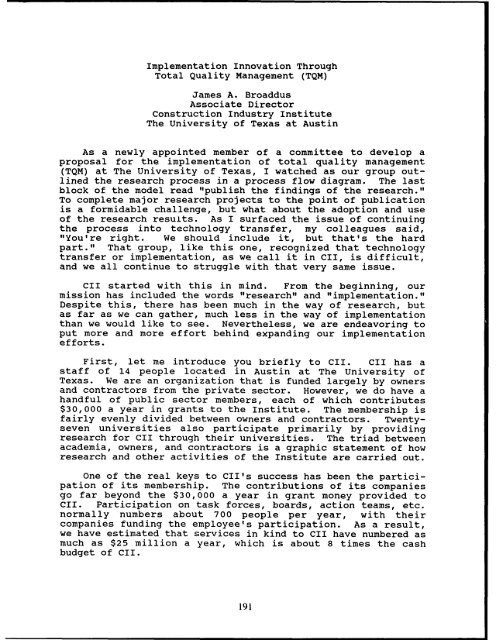Challenges and Opportunities for Innovation in the Public Works ...
Challenges and Opportunities for Innovation in the Public Works ...
Challenges and Opportunities for Innovation in the Public Works ...
Create successful ePaper yourself
Turn your PDF publications into a flip-book with our unique Google optimized e-Paper software.
Implementation <strong>Innovation</strong> Through<br />
Total Quality Management (TQM)<br />
James A. Broaddus<br />
Associate Director<br />
Construction Industry Institute<br />
The University of Texas at Aust<strong>in</strong><br />
As a newly appo<strong>in</strong>ted member of a committee to develop a<br />
proposal <strong>for</strong> <strong>the</strong> implementation of total quality management<br />
(TQM) at The University of Texas, I watched as our group outl<strong>in</strong>ed<br />
<strong>the</strong> research process <strong>in</strong> a process flow diagram. The last<br />
block of <strong>the</strong> model read "publish <strong>the</strong> f<strong>in</strong>d<strong>in</strong>gs of <strong>the</strong> research."<br />
To complete major research projects to <strong>the</strong> po<strong>in</strong>t of publication<br />
is a <strong>for</strong>midable challenge, but what about <strong>the</strong> adoption <strong>and</strong> use<br />
of <strong>the</strong> research results. As I surfaced <strong>the</strong> issue of cont<strong>in</strong>u<strong>in</strong>g<br />
<strong>the</strong> process <strong>in</strong>to technology transfer, my colleagues said,<br />
"You're right. We should <strong>in</strong>clude it, but that's <strong>the</strong> hard<br />
part." That group, like this one, recognized that technology<br />
transfer or implementation, as we call it <strong>in</strong> CII, is difficult,<br />
<strong>and</strong> we all cont<strong>in</strong>ue to struggle with that very same issue.<br />
CII started with this <strong>in</strong> m<strong>in</strong>d. From <strong>the</strong> beg<strong>in</strong>n<strong>in</strong>g, our<br />
mission has <strong>in</strong>cluded <strong>the</strong> words "research" <strong>and</strong> "implementation."<br />
Despite this, <strong>the</strong>re has been much <strong>in</strong> <strong>the</strong> way of research, but<br />
as far as we can ga<strong>the</strong>r, much less <strong>in</strong> <strong>the</strong> way of implementation<br />
than we would like to see. Never<strong>the</strong>less, we are endeavor<strong>in</strong>g to<br />
put more <strong>and</strong> more ef<strong>for</strong>t beh<strong>in</strong>d exp<strong>and</strong><strong>in</strong>g our implementation<br />
ef<strong>for</strong>ts.<br />
First, let me <strong>in</strong>troduce you briefly to CII. CII has a<br />
staff of 14 people located <strong>in</strong> Aust<strong>in</strong> at The University of<br />
Texas. We are an organization that is funded largely by owners<br />
<strong>and</strong> contractors from <strong>the</strong> private sector. However, we do have a<br />
h<strong>and</strong>ful of public sector members, each of which contributes<br />
$30,000 a year <strong>in</strong> grants to <strong>the</strong> Institute. The membership is<br />
fairly evenly divided between owners <strong>and</strong> contractors. Twentyseven<br />
universities also participate primarily by provid<strong>in</strong>g<br />
research <strong>for</strong> CII through <strong>the</strong>ir universities. The triad between<br />
academia, owners, <strong>and</strong> contractors is a graphic statement of how<br />
research <strong>and</strong> o<strong>the</strong>r activities of <strong>the</strong> Institute are carried out.<br />
One of <strong>the</strong> real keys to CII's success has been <strong>the</strong> participation<br />
of its membership. The contributions of its companies<br />
go far beyond <strong>the</strong> $30,000 a year <strong>in</strong> grant money provided to<br />
CII. Participation on task <strong>for</strong>ces, boards, action teams, etc.<br />
normally numbers about 700 people per year, with <strong>the</strong>ir<br />
companies fund<strong>in</strong>g <strong>the</strong> employee's participation. As a result,<br />
we have estimated that services <strong>in</strong> k<strong>in</strong>d to CII have numbered as<br />
much as $25 million a year, which is about 8 times <strong>the</strong> cash<br />
budget of CII.<br />
191







